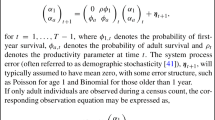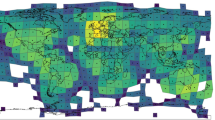Abstract
It has been argued that spatially explicit population models (SEPMs) cannot provide reliable guidance for conservation biology because of the difficulty of obtaining direct estimates for their demographic and dispersal parameters and because of error propagation. We argue that appropriate model calibration procedures can access additional sources of information, compensating the lack of direct parameter estimates. Our objective is to show how model calibration using population-level data can facilitate the construction of SEPMs that produce reliable predictions for conservation even when direct parameter estimates are inadequate. We constructed a spatially explicit and individual-based population model for the dynamics of brown bears (Ursus arctos) after a reintroduction program in Austria. To calibrate the model we developed a procedure that compared the simulated population dynamics with distinct features of the known population dynamics (=patterns). This procedure detected model parameterizations that did not reproduce the known dynamics. Global sensitivity analysis of the uncalibrated model revealed high uncertainty in most model predictions due to large parameter uncertainties (coefficients of variation CV ≈ 0.8). However, the calibrated model yielded predictions with considerably reduced uncertainty (CV ≈ 0.2). A pattern or a combination of various patterns that embed information on the entire model dynamics can reduce the uncertainty in model predictions, and the application of different patterns with high information content yields the same model predictions. In contrast, a pattern that does not embed information on the entire population dynamics (e.g., bear observations taken from sub-areas of the study area) does not reduce uncertainty in model predictions. Because population-level data for defining (multiple) patterns are often available, our approach could be applied widely.
Similar content being viewed by others
References
Beissinger S.R. and Westphal M.I. 1998. On the use of demographic models of population viability in endangered species management. Journal of Wildlife Management 62: 821-841.
Burgman M. and Possingham H.P. 2000. Population viability analysis for conservation: the good, the bad and the undescribed. In: Young A.G. and Clarke G.M. (eds), Genetics, Demography and Viability of Fragmented Populations. Cambridge University Press, London, pp. 97-112.
DeAngelis D.L. and Mooij W.M. 2003. In praise of mechanistically-rich models. In: Canham C., Cole J.J. and Lauenroth W. (eds), Models in Ecosystem Science. Princeton University Press, Princeton, New Jersey.
Doak D.F. and Mills L.S. 1994. A useful role for theory in conservation. Ecology 75: 615-626.
Dunning J.B., Danielson B.J. and Pulliam H.R. 1992. Ecological processes that affect populations in complex landscapes. Oikos 65: 169-175.
Dunning J.B., Stewart D.J., Danielson B.J., Noon B.R., Root T.L., Lamberson R.H. et al. 1995. Spatially explicit population models: current forms and future uses. Ecological Applications 5: 3-11.
Fahrig L. and Merriam G. 1994. Conservation of fragmented populations. Conservation Biology 8: 50-59.
Gaona P., Ferreras P. and Delibes M. 1998. Dynamics and viability of a metapopulation of the endangered Iberian Lynx (Lynx pardinus). Ecological Monographs 68: 349-370.
Grimm V. 1994. Mathematical models and understanding in ecology. Ecological Modelling 75/76: 641-651.
Grimm V., Frank K., Jeltsch F., Brandl R., Uchmanski J. and Wissel C. 1996. Pattern-oriented modelling in population ecology. The Science of the Total Environment 183: 151-166.
Hanski I. 1994. A practical model of metapopulation dynamics. Journal of Animal Ecology 63: 151-162.
Hartway C., Ruckelshaus M. and Kareiva P. 1998. The challenge of applying spatially explicit models to a world of sparse and messy data. In: Bascompte J. and Solé R.V. (eds), Modeling Spatiotemporal Dynamics in Ecology. Springer-Verlag and Landes Bioscience, Berlin, Germany, pp. 215-223.
Higgins S.I., Richardson D.M. and Cowling R.M. 2000. Using a dynamic landscape model for planning the management of alien plant invasions. Ecological Applications 10: 1833-1848.
Hilborn R. and Mangel M. 1997. The Ecological Detective: Confronting Models with Data. Princeton University Press, Princeton, New Jersey.
Jeltsch F., Moloney K.A. and Milton S.J. 1999. Detecting process from snap-shot pattern: lessons from tree spacing in the southern Kalahari. Oikos 85: 451-467.
Kaczensky P. and Knauer F. 2000. Habitat use of bears in a multi-use landscape. In: Kaczensky P. (ed), Co-existence of Brown Bear and Man in the Cultural Landscape of Slovenia. Report of the Institute of Wildlife Biology and Game Management at the Agricultural University of Vienna, Austria.
Kaczensky P., Knauer F., Huber T., Jonozovic M. and Adamic M. 1996. The Ljubljana-Postojna highway-a deadly barrier for brown bears in Slovenia? Journal of Wildlife Research 1: 263-269.
Kaczensky P., Knauer F., Jonozovic M., Walzer C. and Huber T. 2000. Experiences with trapping, immobilization and radiotagging of brown bears in Slovenia. In: Kaczensky P. (ed), Co-existence of Brown Bear and Man in the Cultural Landscape of Slovenia. Report of the Institute of Wildlife Biology and Game Management at the Agricultural University of Vienna, Austria
Kareiva P., Skelly D. and Ruckelshaus M. 1997. Reevaluating the use of models to predict the consequences of habitat loss and fragmentation. In: Pickett S.T.A., Ostfeld R.S., Shachak H. and Likens G.E. (eds), The Ecological Basis for Conservation. Chapman & Hall, New York, pp. 156-166.
Kendall B.E., Briggs C.J., Murdoch W.W., Turchin P., Ellner S.P., McCauley E. et al. 1999. Why do populations cycle? A synthesis of statistical and mechanistic modeling approaches. Ecology 80: 1789-1805.
Levin S.A. 1992. The problem of pattern and scale in ecology. Ecology 73: 1943-1967.
Lima S.L. and Zollner P.A. 1996. Towards a behavioral ecology of ecological landscapes. Tree 11: 131-135.
Lindenmayer D.B., Lacy R.C. and Pope M.L. 2000. Testing a simulation model for population viability analysis. Ecological Applications 10: 580-597.
McCarthy M.A., Burgman M.A. and Ferson S. 1995. Sensitivity analysis for models of population viability. Biological Conservation 73: 93-100.
McCarthy M.A., Lindenmayer D.B. and Possingham H.P. 2000. Testing spatial PVA models of Australian treecreepers (Aves: Climacteridae) in fragmented forest. Ecological Applications 10: 1722-1731.
Meir E. and Kareiva P. 1997. Contributions of spatially explicit landscape models to conservation biology. In: Fiedler P.L. and Kareiva P. (eds), Conservation Biology for the Coming Decade. 2nd edn. Chapman & Hall, New York, pp. 497-507.
Mladenoff D.J., Sickley T.A. and Wydeven A.P. 1999. Predicting gray wolf landscape recolonization: logistic regression models vs. new field data. Ecological Applications 9: 37-44.
Moloney K.A. 1993. Determining process through pattern: reality or fantasy? In: Levin S.A., Powell T.M. and Steele J.H. (eds), Lecture Notes in Biomathematics Vol. 96. Springer-Verlag, New York, pp. 61-69.
Mooij W.M. and DeAngelis D.L. 1999. Error propagation in spatially explicit population models: a reassessment. Conservation Biology 13: 930-933.
Pulliam H.R. and Dunning J.B. 1995. Spatially explicit population models. Ecological Applications 5: 2.
Railsback S.F. and Harvey B.C. 2002. Analysis of habitat-selection rules using an individual-based model. Ecology 83: 1817-1830.
Rauer G.B. and Gutleb 1997. Der Braunbär in Österreich. Monographie. Federal Environment Agency-Austria, Vienna, Austria.
Rauer G.B., Aubrecht P., Gutleb B., Kaczensky P., Knauer F., Plutzar C. et al. 2001. Der Braunbär in Österreich II. Vol. M-110. Federal Environment Agency, Vienna, Austria.
Ruckelshaus M., Hartway C. and Kareiva P. 1997. Assessing the data requirement of spatially explicit dispersal models. Conservation Biology 11: 1298-1306.
Ruckelshaus M., Hartway C. and Kareiva P. 1999. Dispersal and landscape errors in spatially explicit population models: a reply. Conservation Biology 13: 1223-1224.
Rushton S.P., Barreto G.W., Cormack R.M., Macdonald D.W. and Fuller R. 2000. Modelling the effects of mink and habitat fragmentation on the water vole. Journal of Applied Ecology 37: 475-490.
Schadt S., Revilla E., Wiegand T., Knauer F., Kaczensky P., Breitenmoser U. et al. 2002. Assessing the suitability of central European landscapes for the reintroduction of Eurasian lynx. Journal of Applied Ecology 39: 189-203.
Sæther B.-E., Engen S., Swenson J.E., Bakke Ø. and Sandegren F. 1998. Viability of Scandinavian brown bear Ursus arctos populations: the effects of uncertain parameter estimates. Oikos 83: 403-416.
South A. 1999. Dispersal in spatially explicit population models. Conservation Biology 13: 1039-1046.
Swenson J.E., Sandegren F. and Söderberg A. 1998. Geographic expansion of an increasing brown bear population: evidence for presaturation dispersal. Journal of Animal Ecology 67: 819-826.
Swenson J.E., Gerstl N., Dahle B. and Zedrosser A. 2000. Action plan for the conservation of the brown bear (Ursus arctos) in Europe. Council of Europe, Report T-PVS (2000) 24.
Turchin P. 2003. Complex Population Dynamics: A Theoretical/Empirical Synthesis. Princeton University Press, Princeton, New Jersey.
Wennergren U., Ruckelshaus M. and Kareiva P. 1995. The promise and limitations of spatial models in conservation biology. Oikos 74: 349-356.
Wiegand T., Naves J., Stephan T. and Fernandez A. 1998. Assessing the risk of extinction for the brown bear (Ursus arctos) in the Cordillera Cantabrica, Spain. Ecological Monographs 68: 539-571.
Wiegand T., Moloney K.A., Naves J. and Knauer F. 1999. Finding the missing link between landscape structure and population dynamics: a spatially explicit perspective. The American Naturalist 154: 605-627.
Wiegand T., Jeltsch F., Hanski I. and Grimm V. 2003. Using pattern-oriented modeling for revealing hidden information: a key for reconciling ecological theory and application. Oikos 100: 209-222.
Wiegand T., Knauer F., Kaczensky P. and Naves J. 2004. Expansion of brown bears (Ursus arctos) into the eastern Alps: a spatially explicit population model. Biodiversity and Conservation 13: 79-114 (this issue).
Wiens J.A., Stenseth N.C., van Horne B. and Ims R.A. 1993. Ecological mechanisms and landscape ecology. Oikos 66: 369-380.
Wood S.N. 2001. Partially specified ecological models. Ecological Monographs 71: 1-25.
Zedrosser A., Gerstl N. and Rauer G. 1999. Brown Bears in Austria. Vol. M-117. Federal Environment Agency, Vienna, Austria.
Author information
Authors and Affiliations
Corresponding author
Rights and permissions
About this article
Cite this article
Wiegand, T., Revilla, E. & Knauer, F. Dealing with Uncertainty in Spatially Explicit Population Models. Biodiversity and Conservation 13, 53–78 (2004). https://doi.org/10.1023/B:BIOC.0000004313.86836.ab
Issue Date:
DOI: https://doi.org/10.1023/B:BIOC.0000004313.86836.ab




